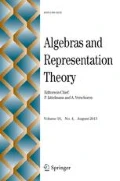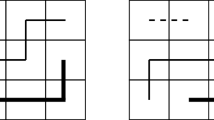Abstract
Regarding the Specht modules associated to the two-row partition (n, n), we provide a combinatorial path model to study the transitioning matrix from the tableau basis to the A1-web basis (i.e. cup diagrams), and prove that the entries in this matrix are positive in the upper-triangular portion with respect to a certain partial order.
Similar content being viewed by others
References
Brown, G.C., Davidson, N.J., Kujawa, J.R.: Quantum webs of type q (2020)
Brown, G.C.: Webs for permutation supermodules of type Q. Comm. Algebra 47(11), 4763–4790 (2019). MR 3991050
Cautis, S., Kamnitzer, J., Morrison, S.: Webs and quantum skew Howe duality. Math. Ann. 360(1-2), 351–390 (2014)
Etingof, P., Gelaki, S., Nikshych, D., Ostrik, V.: Tensor Categories, Mathematical Surveys and Monographs, vol. 205. American Mathematical Society, Providence (2015). MR 3242743
Fulton, W.: Young Tableaux, London Mathematical Society Student Texts, vol. 35. Cambridge University Press, Cambridge (1997). With applications to representation theory and geometry
Fung, F.Y.C.: On the topology of components of some Springer fibers and their relation to Kazhdan-Lusztig theory. Adv. Math. 178(2), 244–276 (2003)
Green, J.A.: Polynomial Representations of gln Lecture Notes in Mathematics, vol. 830. Springer, Berlin (1980)
Im, M.S., Lai, C.-J., Wilbert, A.: Irreducible components of two-row Springer fibers and Nakajima quiver varieties (2019)
Khovanov, M., Kuperberg, G.: Web bases for \(\mathfrak {sl}(3)\) are not dual canonical. Pacific J. Math. 188(1), 129–153 (1999)
Kuperberg, G.: Spiders for rank 2 Lie algebras. Comm. Math. Phys. 180(1), 109–151 (1996)
Petersen, T.K., Pylyavskyy, P., Rhoades, B.: Promotion and cyclic sieving via webs. J. Algebraic Combin. 30(1), 19–41 (2009)
Rhoades, B.: The polytabloid basis expands positively into the web basis. arXiv:1808.00445 (2018)
Russell, H.M., Tymoczko, J.: Springer representations on the Khovanov Springer varieties. Math. Proc. Cambridge Philos. Soc. 151, 59–81 (2011)
Russell, H.M., Tymoczko, J.S.: The transition matrix between the Specht and web bases is unipotent with additional vanishing entries. Int. Math. Res. Not. IMRN 5, 1479–1502 (2019)
Rumer, G., Teller, E., Weyl, H.: Eine für die valenztheorie geeignete basis der binären vektorinvarianten, nachrichten von der ges. der wiss, Zu göttingen. Math.-Phys. Klasse, 498–504 (1932)
Sagan, B.E.: The Symmetric Group, Second Ed., Graduate Texts in Mathematics, vol. 203. Springer, New York (2001). Representations, combinatorial algorithms, and symmetric functions
Spaltenstein, N.: The fixed point set of a unipotent transformation on the flag manifold. Nederl. Akad. Wetensch. Proc. Ser. A 79=Indag. Math. 38(5), 452–456 (1976)
Stanley, R.P.: Enumerative Combinatorics. Vol. 2, Cambridge Studies in Advanced Mathematics, vol. 62. Cambridge University Press, Cambridge (1999). With a foreword by Gian-Carlo Rota and appendix 1 by Sergey Fomin. MR 1676282
Steinberg, R.: An occurrence of the Robinson-Schensted correspondence. J. Algebra 113(2), 523–528 (1988)
Stroppel, C., Webster, B.: 2-block Springer fibers: convolution algebras and coherent sheaves. Comment. Math. Helv. 87, 477–520 (2012)
Stroppel, C., Wilbert, A.: Two-block Springer fibers of types C and d: a diagrammatic approach to Springer theory. Math. Z. 292(3-4), 1387–1430 (2019)
Temperley, H.N.V., Lieb, E.H.: Relations between the percolation and colouring problem and other graph-theoretical problems associated with regular planar lattices: some exact results for the percolation problem. Proc. Roy. Soc. London Ser. A 322(1549), 251–280 (1971). MR 498284
Tubbenhauer, D., Vaz, P., Wedrich, P.: Super q-Howe duality and web categories. arXiv:1504.05069 (2015)
Vargas, J.A.: Fixed points under the action of unipotent elements of SLn in the flag variety. Bol. Soc. Mat. Mexicana 24(1), 1–14 (1979)
Acknowledgements
This project started at the Summer Collaborators Program based at the School of Mathematics at the Institute for Advanced Study. We thank their hospitality in hosting our research group, their generous help throughout our stay at Princeton, and their financial support to facilitate this project.
We also thank the other two research members in our group, Chun-Ju Lai and Arik Wilbert, for their contribution to the project. Specifically, we thank A.W. for bringing to us the original problem and potential methods of attacking the problem; his broad knowledge on the subject matter has been our continuous go-to source for literature reference. We thank C.-J.L. for his sharp insight for pointing out several mistakes in our proofs and his suggestions for improvement, as well as coding resources for a portion of the diagrams in this article. This project would not have been successful without their engagement.
The authors also thank Jonathan Kujawa, Julianna Tymoczko, and Mikhail Khovanov for helpful conversations. M.S.I. also acknowledges Joseph Gamson, Eric Basque, Venkat R. Dasari, National Academy of Sciences, and Army Research Laboratory for supporting this project.
Author information
Authors and Affiliations
Corresponding author
Additional information
Presented by: Vyjayanthi Chari
Publisher’s Note
Springer Nature remains neutral with regard to jurisdictional claims in published maps and institutional affiliations.
Rights and permissions
About this article
Cite this article
Im, M.S., Zhu, J. Transitioning Between Tableaux and Spider Bases for Specht Modules. Algebr Represent Theor 25, 387–399 (2022). https://doi.org/10.1007/s10468-020-10026-6
Received:
Accepted:
Published:
Issue Date:
DOI: https://doi.org/10.1007/s10468-020-10026-6




